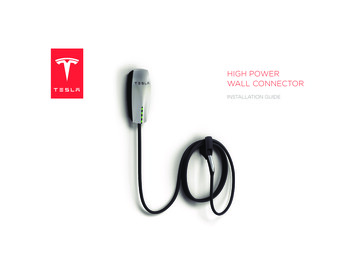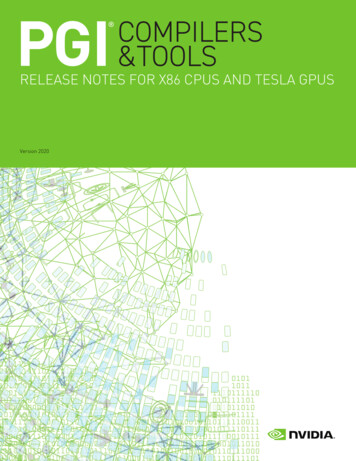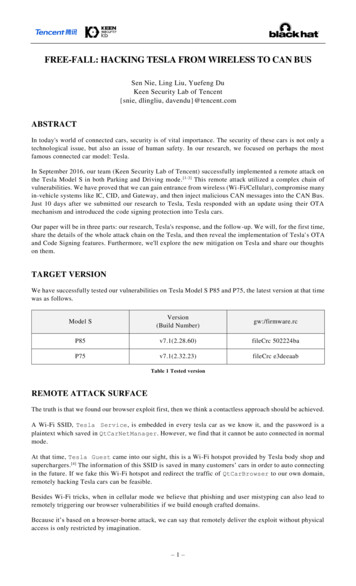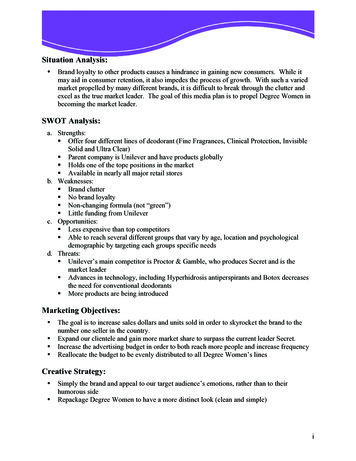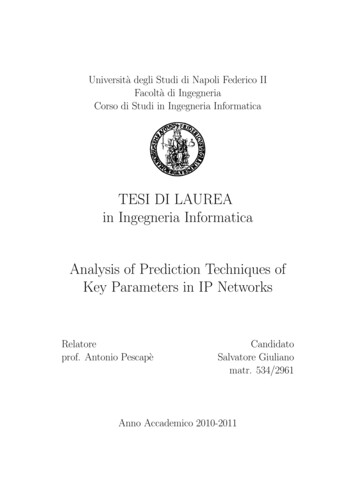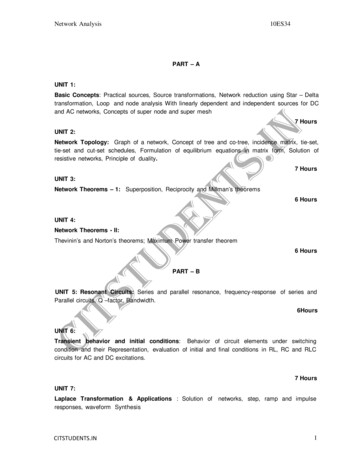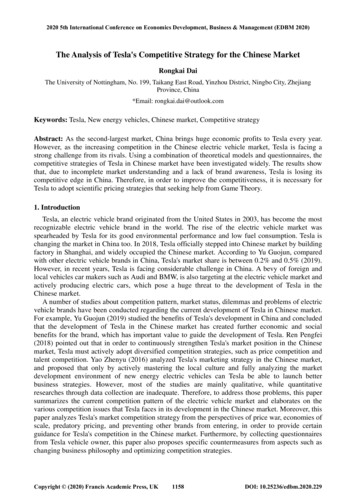
Transcription
2020 5th International Conference on Economics Development, Business & Management (EDBM 2020)The Analysis of Tesla's Competitive Strategy for the Chinese MarketRongkai DaiThe University of Nottingham, No. 199, Taikang East Road, Yinzhou District, Ningbo City, ZhejiangProvince, China*Email: rongkai.dai@outlook.comKeywords: Tesla, New energy vehicles, Chinese market, Competitive strategyAbstract: As the second-largest market, China brings huge economic profits to Tesla every year.However, as the increasing competition in the Chinese electric vehicle market, Tesla is facing astrong challenge from its rivals. Using a combination of theoretical models and questionnaires, thecompetitive strategies of Tesla in Chinese market have been investigated widely. The results showthat, due to incomplete market understanding and a lack of brand awareness, Tesla is losing itscompetitive edge in China. Therefore, in order to improve the competitiveness, it is necessary forTesla to adopt scientific pricing strategies that seeking help from Game Theory.1. IntroductionTesla, an electric vehicle brand originated from the United States in 2003, has become the mostrecognizable electric vehicle brand in the world. The rise of the electric vehicle market wasspearheaded by Tesla for its good environmental performance and low fuel consumption. Tesla ischanging the market in China too. In 2018, Tesla officially stepped into Chinese market by buildingfactory in Shanghai, and widely occupied the Chinese market. According to Yu Guojun, comparedwith other electric vehicle brands in China, Tesla's market share is between 0.2% and 0.5% (2019).However, in recent years, Tesla is facing considerable challenge in China. A bevy of foreign andlocal vehicles car makers such as Audi and BMW, is also targeting at the electric vehicle market andactively producing electric cars, which pose a huge threat to the development of Tesla in theChinese market.A number of studies about competition pattern, market status, dilemmas and problems of electricvehicle brands have been conducted regarding the current development of Tesla in Chinese market.For example, Yu Guojun (2019) studied the benefits of Tesla's development in China and concludedthat the development of Tesla in the Chinese market has created further economic and socialbenefits for the brand, which has important value to guide the development of Tesla. Ren Pengfei(2018) pointed out that in order to continuously strengthen Tesla's market position in the Chinesemarket, Tesla must actively adopt diversified competition strategies, such as price competition andtalent competition. Yao Zhenyu (2016) analyzed Tesla's marketing strategy in the Chinese market,and proposed that only by actively mastering the local culture and fully analyzing the marketdevelopment environment of new energy electric vehicles can Tesla be able to launch betterbusiness strategies. However, most of the studies are mainly qualitative, while quantitativeresearches through data collection are inadequate. Therefore, to address those problems, this papersummarizes the current competition pattern of the electric vehicle market and elaborates on thevarious competition issues that Tesla faces in its development in the Chinese market. Moreover, thispaper analyzes Tesla's market competition strategy from the perspectives of price war, economies ofscale, predatory pricing, and preventing other brands from entering, in order to provide certainguidance for Tesla's competition in the Chinese market. Furthermore, by collecting questionnairesfrom Tesla vehicle owner, this paper also proposes specific countermeasures from aspects such aschanging business philosophy and optimizing competition strategies.Copyright (2020) Francis Academic Press, UK1158DOI: 10.25236/edbm.2020.229
2. Competitive Landscape of China's Electric Vehicle Market2.1 Tesla's Main CompetitorsAmong all the products from Tesla’s competitors, Jaguar I-pace, Audi E-tron, and Audi E-tronSUV have been seen a major challenge for Tesla and they all have strong performances. I-PACE hasJaguar's strongest intelligent all-aluminum body structure: the front and rear axles are equippedwith high-density and energy-efficient coaxial permanent magnet dual motors, which accelerate for4.8 seconds in 100 kilometers. Audi E-tron SUV can accelerate for 5.5 seconds per 100 kilometerswith maximum speed of 200Km / h. Although it differs from the 4.3S and 250Km / h of the ModelS P100D, Audi said it will launch a more powerful GT version. The Audi E-tron SUV's systemoutput can reach 300kW (408PS) with peak torque of 664N m and cruising range of 400Km, andit can accelerate to100 km/h within 5.7 seconds. Tesla differs from these electric vehicles in manyways. In terms of appearance, Tesla’s design is more elegant, versatile, high-quality, andenvironmental friendly. In terms of market positioning, most electric car companies adopt an online offline sales mode. Although Tesla is not the only company that offers online purchasing forcustomers, it is more attractive for the reasons that all models are purchased online and custom built.Tesla also targets at a different group of people with other brands too. Most tesla’s competitorstarget at younger groups, while Tesla's target customers are middle-aged groups. Furthermore, thebrand effects of cars such as Audi and BMW pose some threats to Tesla's marketing. For years,traditional European automobile companies such as Audi and BMW have dominated the Chineseluxury car market, and they are favored by Chinese people as a symbol of wealth and social status.However, Tesla just entered the Chinese market in 2008 and it has a long way to catch up.2.2 Tesla Customer SatisfactionTo investigate the current customer satisfaction of Tesla in the Chinese market, a questionnairesurvey was conducted during the study. The questionnaire consists of ten questions regarding thebasic information of the respondents, the purchase experience of Tesla, and the satisfaction of therespondents with Tesla. The questionnaire was distributed on the questionnaire website (here is theURL), and 206 valid questionnaires were collected.Table 1 Analysis of The Basic Situation of the RespondentsSocial statistical variablesgenderageEducationPurchase experiencemalefemale 20 years old20-30 years old30-40 years old40-50 years old 50 years oldprimary schoolmiddle schoolcollegeBachelor and 1.940.0053.446.6From Figure 1, 33% of the respondents expressed different degrees of satisfaction with Tesla'safter-sales service, of which 12.5% respondents are “strongly satisfied” and 20.5% are “satisfied”.The proportion of dissatisfaction with after-sales service was 20.8%, and the percent of “verydissatisfied” was 9.00%. Among 20-30 year-old respondents, more than half of them were notsatisfied with Tesla's after-sales service. According to the results of the questionnaire survey, it canbe concluded that many customers are not very satisfied with Tesla's after-sales service and Teslastill has a lot to improve.1159
Fig.1 Consumer Satisfaction with Tesla's after Sales ServiceFig.2 Survey of Tesla's Quality SatisfactionFigure 2 shows the degree of satisfaction with Tesla’s car quality. From the data collected, over34% of respondents expressed dissatisfaction with the quality of Tesla products. And according toBloomberg’s research, 101 issues out of 100 cars sold were reported in February 2019 with mostissues in the car’s exterior. So the quality of Tesla products needs to be further improved.Finally, an analysis about the price of Tesla was also proceeded in this research. The relevantstatistics is shown below:According to Figure 3, more than 20% of consumers are less satisfied with the price of Tesla,and Tesla definitely need to adopt different price strategies to attract more customer.An analysis of Tesla's after-sales service satisfaction, products, and prices through randomsurveys shows that there are many more common problems. In particular, after-sales service,products, and prices need to be further improved.1160
Fig.3 Survey of Tesla's Price Satisfaction2.3 Development Status of China's New Energy Vehicle MarketReducing the sales of gasoline-powered vehicles has gradually become a global trend. In China,the traditional energy cars has been issued the policy of environment positive and negative pointssince April 1st, 2018, while new energy vehicles onwards accounted for the positive and negativepoints since January 1st, 2019. The implementation of the double-point policy and the subsidypolicy have stimulated the rapid development of new energy vehicles, making it an unavoidable hottrend in recent years.In China, the yields and sales of new energy vehicles in 2018 were 1.27 million and 1.256million respectively, of which pure electric vehicle production and sales still dominated the market,and plug-in hybrid vehicles and fuel cell vehicles have seen rapid growth (China Industry ResearchInstitute, 2019) . With the continuous development of the new energy electric vehicle market, morecompanies have joined the competition and want to split the market for profit. With the gradualdecrease of the subsidy of new energy vehicles, technology is forced to be upgraded in order to helpauto companies improve their product competitiveness. The electric vehicle industry, which wascompletely driven by policies in the past, will gradually be driven by the market (Yu Guojun, ShenYijia, 2019). Driven by subsidies, new energy vehicle sales have been very largely increased, from0.36 million in 2015 to 126 million in 2018. And for 2019, the sales is about 160 to 170 million.Moreover, by 2020, the new energy vehicle sales will hit 200 million, which indicates that theindustry's compound annual growth rate is about 40% (China Industry Research Institute, 2019).As Figure 4 shown, Chinese new energy vehicle production has suffered a certain decline since2018, and at January in 2019 reaching its peak production, and then declining 0%66%2020162017Sales (thousands)201820190rate of riseFig.4 China's New Energy Vehicle Production and Growth Trend from June 2018 to June 20191161
At present, from the perspective of production capacity, the output of China's new energy electricvehicles has clearly exceeded the sales volume. The current output of new energy electric vehiclessuch as Audi, BMW, Volkswagen, and Pentium is greater than sales. For example, in 2018 ,the sales of new energy electric vehicles such as Audi, BMW, Volkswagen, and Pentiumexceeded 200,000 in China . The output of new energy electric vehicles was 215,000 . Not good forthe development of new energy electric vehicle industry.At present, the number of companies in the Chinese new energy electric vehicle market isincreasing. In addition to Tesla, Weilai, Xiaopeng and other new energy vehicle companies, Audi,BMW, Volkswagen, Pentium and other traditional automobile companies have also begun toproduce new energy electric vehicles. 2018 Audi's new energy electric vehicle salesexceeded 5 million units, market share of more than 3 %2.00%0.00%5002.50%201620172018Operating income ( 100 million)20190rate of riseFig.5 Income Situation of 37 Listed Companies in the New Energy Vehicle Industry Chain in theSecond Quarter of 2019.From Figure 5, it can be seen that in the quarter, China's new energy auto market is relativelyfavorable developments, and in the second quarter of 2019, the 37 listed companies' revenuesituation optimism.At present, the competition of the new energy electric vehicle market is relatively fierce. Sinceentering 2018 , the market development of China's new energy electric vehicles has begun to enterthe oligopoly era, and a large numbers of market monopolies have occurred.3. Entry and Blocking3.1 Tesla's Experience in Successfully Entering the Chinese MarketAlthough under the background of modernization, Tesla's popularity and influence in theChinese market are not great. But Tesla's ability to enter the Chinese market quickly has a closerelationship with Tesla's market management experience. Tesla's main experience in choosing toenter the Chinese market is the dynamic observation of new energy vehicle policies in the Chinesemarket. It can closely integrate the changes in the policy of the new energy vehicle industry inChina to change its management philosophy, and only grasp the goodness of the new energy policy.Time to enter the Chinese market.3.2 How Tesla Prevents Potential Competitors from Entering the IndustryIn applying the game strategy to prevent competitors, Tesla adopted excess production capacity,excess research and development technology, and predatory pricing. These methods are in line withthe content of the game model. However, the application of these measures may cause Tesla's lossesto increase and the board of directors to be dissatisfied, so it needs to be handled appropriately and1162
scientifically considered.Tesla's success in entering the Chinese market is due to Tesla's scientific grasp of the Chinesenew energy electric vehicle market and its analysis of new policies. Tesla has adopted some pricestrategies and product strategies to prevent potential competitors from entering the industry. Teslaoperators are also good at applying game models, but in specific reality, there are still somedifferences between Tesla's current situation and model background assumptions. Therefore,according to the excess production capacity, excess R & D technology and predatory pricingmethods adopted by Tesla, this paper conducts related research and analyzes the impact of thesemethods on Tesla. In the short term, these methods will not bring losses to Tesla or make the bo
such asAudi, BMW, Volkswagen, and Pentium is greater than sales. For example, in 2018 , the sales of new energy electric vehicles such asAudi, BMW, Volkswagen, and Pentium exceeded 200,000 in China . The output of new energy electric vehicles was 215,000 . Not good for the development of new energy electric vehicle industry.
